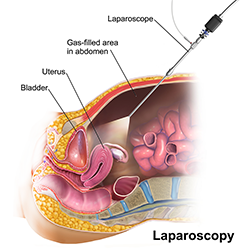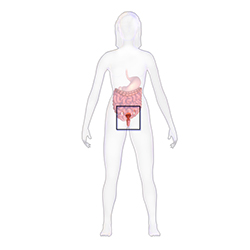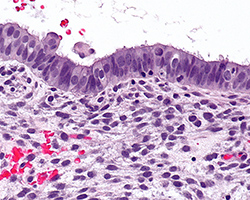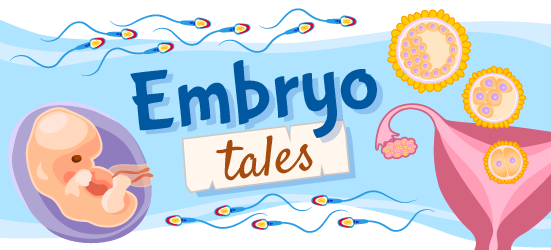
Shedding Light on Endometriosis
Illustrated by: Sabine Deviche
show/hide words to know
Endometriosis: a condition that causes tissue that should grow inside the uterus to grow outside instead. This can cause severe pain.
Endometrium: tissue that lines the inside of the uterus. The endometrium sheds each month during a period.
Fallopian tube: a structure inside female body that connects an ovary to the uterus.
Laparoscopy: a type of surgery in which a doctor makes a small incision on the lower stomach and inserts a small camera to see inside the body.
Ovary: creates and stores the female reproductive cells in plants and animals.
Ovulation: when the female reproductive system releases an egg cell. That egg cell can be fertilized by sperm to start a pregnancy.
Period: the shedding of the inside of the uterus, which normally happens about once a month and lasts five to seven days. Periods usually start around age twelve to fifteen and are also called menstruation.
Uterus: or womb is a major female reproductive sex organ of most mammals including humans. It is within the uterus that the fetus develops... more
Vagina: a part of the female body that connects the uterus the outside the body.
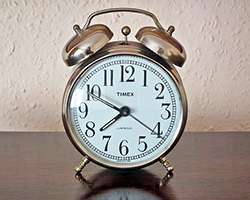
You might have normal routines on school or work days, like waking up at the same time and making breakfast. Our bodies have normal routines as well. Image by MrGajowy3 via Pixabay.
Perhaps you have a normal routine. Every day, you wake up in the early morning, eat toast and fruit for breakfast, dress, and pack your backpack for school. But sometimes, there can be hiccups in normal routines. Today is definitely one of those abnormal days. Your alarm clock didn’t go off in the morning and your backpack is mysteriously missing.
Your body has normal routines too. One example is the menstrual cycle, which prepares the body for the possibility of pregnancy. It starts with menstruation, or a period. Periods usually happen once a month and last for three to seven days, but they can be shorter or longer. During periods, the levels of a hormone called estrogen decrease in the body. This tells the uterus to shed its inner tissue lining. The inner tissue lining of the uterus is also called the endometrium. When the tissue lining sheds, it leaves the body through the vagina. But sometimes, that's not exactly how it happens.
The process is a bit different in people with endometriosis. Their endometrium will grow outside of the uterus. Those growths, or lesions, are commonly found on the ovaries and fallopian tubes. During periods, those lesions can swell and bleed, like the normal endometrium does. But because they grow outside the uterus, the lesions do not shed and leave the body. Instead, those lesions may continue to grow, become larger, or thicker. That may cause a lot of pain.
In the Embryo Project article “Endometriosis,” writers talk about how endometriosis affects the menstrual cycle.
Painful Problems
Your day is undoubtedly not going well. You’re late to school and cannot find your missing backpack. And just when you think that things couldn’t be worse, you feel your head start to ache. Throughout the day, the pain gets worse and worse. Running to the bathroom and looking in the mirror, you notice that you look perfectly normal.

Endometriosis causes a lot of pain for some women. Image by Anastasia Gepp via Pixabay.
Much like a person with a headache, a person with endometriosis may look healthy but feel a lot of pain. The pain that endometriosis causes may even be so severe that it keeps the person from going to school.
Endometriosis may also cause a person to become infertile, which means they can't become pregnant. That is because lesions can make it hard for an egg to move through the fallopian tubes during ovulation. Because of this, it can be difficult for an egg to be fertilized.
Looking for Lesions
It is hard to know when a person has endometriosis. That is because periods or ovulation can be painful whether a person has endometriosis or not. So a person may not suspect that something is wrong. A person can go years before finding out they have endometriosis.
The only way to diagnose endometriosis is by testing the tissues involved. To do this, two techniques are used: laparoscopic surgery and tissue biopsy.
Have you been to see the doctor and she used a popsicle stick to hold down your tongue and better see the inside of your mouth and throat? Like a handy popsicle stick, laparoscopic surgery lets a doctor have a better view inside the body. First, a doctor inserts a very tiny camera through a small cut on the lower stomach. This camera is called a laparoscope. The camera lets the doctor see inside the body and look for lesions.
Lesions are abnormal growths of tissue. Doctors look for lesions on the fallopian tubes and ovaries. If the doctor finds a lesion, then she performs a tissue biopsy. The doctor takes a sample from the lesion and later examines it under a microscope. If the lesion looks like endometrial tissue, then the person may have endometriosis.
Handling Endometriosis with Hormones
There is currently no cure for endometriosis, but there are many ways to treat the pain. Doctors can also use laparoscopic surgery to extract the lesions from inside the body. A person may also choose a treatment like hormone therapy.
Hormone therapies can help control the amount of hormones like estrogen in the body. Some of those treatments can stop the body from producing estrogen. Estrogen tells the endometrium to become thick during the menstrual cycle. Stopping the production of estrogen, then, can help stop lesions from growing.
Endometriosis is still a bit of a mystery to scientists. They don't really know why some people get endometriosis or the best way to treat it. While they study endometriosis, doctors also work to help people handle the pain and infertility it causes.
Abnormal Anatomy
One of the first people to notice endometriosis was a doctor in Vienna in the 19th century named Karl Freheirr von Rokitansky. Rokitansky cut open dead bodies to study them. That's called performing an autopsy. He even performed an autopsy on composer Ludwig van Beethoven’s body. Rokitansky did autopsies to learn why people died and how disease affected human bodies.
During one autopsy, Rokitansky closely looked at a female body. Scribbling his observations onto paper, he took careful note of the body. But, he paused when he saw something unusual on the uterus. Rokitansky used his tools to take the abnormality from the uterus and takes a closer look at it. Using a microscope, he noticed that it looked a lot like what he remembered the endometrium to look like.
Rokitansky shared his findings with other scientists, but no one looked into the matter again until much later. In the 1920s, scientist Thomas Cullen sketched a diagram of what the lesions looked like inside the body. Cullen’s diagram helped doctors detect endometriosis in their patients. They were able to know what lesions look like and where to find them.
Today, scientists and doctors continue to learn more about endometriosis. They look for easier ways to diagnose endometriosis. One of those scientists is Christine Metz. She works in Manhasset, New York, to test the menstrual blood of patients with and without endometriosis. Her team noticed something curious about the cells of the endometrium. Those are called stromal cells. Normally, stromal cells change to help the endometrium nourish an embryo during pregnancy. But Metz saw that those cells looked different in her patients with endometriosis as they transformed.
Metz's finding could make it easier for doctors to diagnose endometriosis. Doctors might just be able to look at stromal cells instead of performing surgery. Then patients can begin treatment sooner to reduce pain and avoid infertility.
But until scientists like Metz create easier ways to diagnose endometriosis, people need to know its symptoms. Then, people may be able to seek treatment earlier, experience less pain, and miss fewer days of school or work.
This Embryo Tale was edited by Risa Schnebly and is based on the following Embryo Project articles:
Santora, Emily. "Karl Freiherr von Rokitansky (1804-1878)." Embryo Project Encyclopedia (2019-09-20). ISSN: 1940-5030 https://embryo.asu.edu/handle/10776/13119.
Santora, Emily and Guerrero, Anna. “Leuprorelin as a Treatment for Endometriosis.” Embryo Project Encyclopedia (2019-11-30). ISSN: 1940-5030 https://embryo.asu.edu/handle/10776/13136.
Santora, Emily. "Novasure Endometrial Ablation." Embryo Project Encyclopedia (2019-08-12). ISSN: 1940-5030 https://embryo.asu.edu/handle/10776/13124.
Van Iten, Brendan. “Estrogen and the Menstrual Cycle in Humans.” Embryo Project Encyclopedia (2016-06-22). ISSN: 1940-5030 https://embryo.asu.edu/handle/10776/11344.
Additional images via Wikimedia Commons. The uterus clay sculpture file comes from Wellcome Images, a website operated by Wellcome Trust, a global charitable foundation based in the United Kingdom.
View Citation
Bibliographic details:
- Article: Shedding Light on Endometriosis
- Author(s): Emily Santora
- Publisher: Arizona State University School of Life Sciences Ask A Biologist
- Site name: ASU - Ask A Biologist
- Date published: August 31, 2021
- Date accessed: April 17, 2024
- Link: https://askabiologist.asu.edu/embryo-tales/endometriosis
APA Style
Emily Santora. (2021, August 31). Shedding Light on Endometriosis. ASU - Ask A Biologist. Retrieved April 17, 2024 from https://askabiologist.asu.edu/embryo-tales/endometriosis
Chicago Manual of Style
Emily Santora. "Shedding Light on Endometriosis". ASU - Ask A Biologist. 31 August, 2021. https://askabiologist.asu.edu/embryo-tales/endometriosis
Emily Santora. "Shedding Light on Endometriosis". ASU - Ask A Biologist. 31 Aug 2021. ASU - Ask A Biologist, Web. 17 Apr 2024. https://askabiologist.asu.edu/embryo-tales/endometriosis
MLA 2017 Style

Be Part of
Ask A Biologist
By volunteering, or simply sending us feedback on the site. Scientists, teachers, writers, illustrators, and translators are all important to the program. If you are interested in helping with the website we have a Volunteers page to get the process started.







